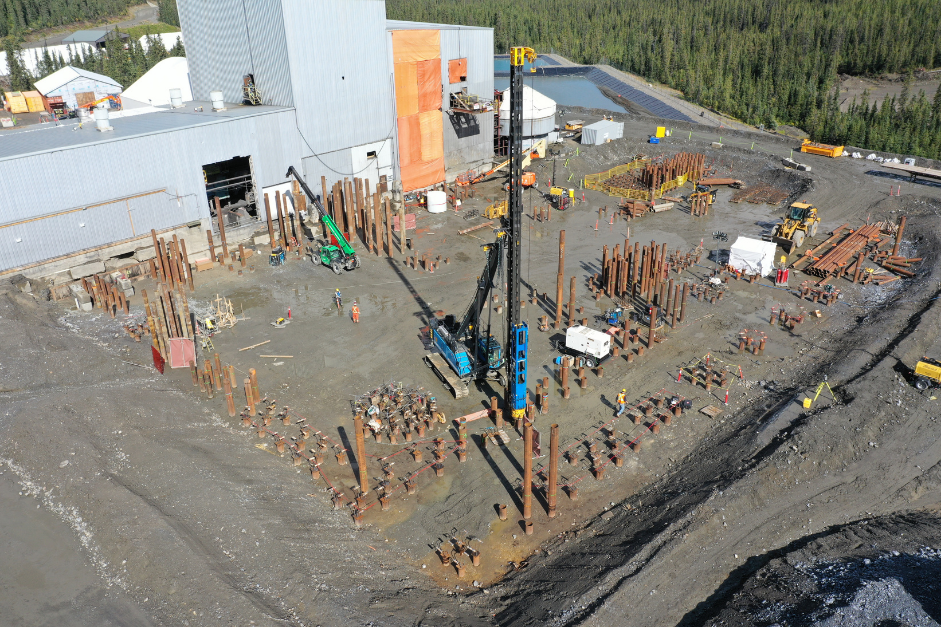The main applications of the piles can be summarized as follows:
- Foundation in a weak ground condition
- To resist uplift or overturning forces
- To control the settlement for sensitive equipment
- To carry lateral loads
- Foundation in expansive or collapsible soil
- Bridge abutments
- In offshore construction
- For a deep excavation, as the earth-retaining support
Piles can be constructed and installed in a variety of ways, depending on their type and the ground's conditions. Generally, piles can be classified into three basic categories:
- Large displacement piles comprise all types of driven and cast-in-place piles with the closed-end tip.
- Small displacement piles have a relatively small cross-section area. They include H-piles and pipe piles driven with an open end such that the soil enters the hollow section.
- Replacement piles are formed by removing the soil by a boring technic and placing reinforced concrete into a cased or non-cased hole. Pre-cast concrete, timber or steel piles can also be placed in the drilled hole and be included in this category.
Selecting the appropriate pile type depends on the type of project structure and location, subsurface conditions and the expected project lifetime. For land structures, any of the above categories can be considered for piling, while displacement piles are the first choice for a marine structure.
While materials for piles, installation and fabrication can be precisely specified, calculating their bearing capacity is a complex procedure that currently is based on theoretical concepts derived from soil and rock mechanics but mainly on empirical methods based on experience. Each of these equations and analytical solutions has its limitations and assumptions, resulting in differences in the prediction of the actual pile bearing capacity. Furthermore, varying soil conditions and unreliable soil parameters cause additional uncertainties, demonstrating the importance of in-situ pile load tests at the beginning of the pile installation.
Pile load testing can be divided into three main categories:
- Static pile load testing
- Dynamic load testing using the Pile Driving Analyzer (PDA) system
- Pile integrity testing (PIT)
Static pile load tests are the most accurate means of determining pile capacity; however, they are expensive, and they may not be practicable due to accessibility issues on some sites. Alternatively, the PDA system is the most popular tool for determining the axial pile capacity.
The PDA tests involve generating an impulse using the pile hammer (for driven piles) or a drop weight (for bored piles), then determining pile integrity and pile capacity using signal matching. By using the downward wave as an input, the signal matching method iteratively adjusts a numerical soil-pile interface model until a comparison can be made between the computed reflected upward force wave and the measured reflected upward force wave. The most common software used for signal matching is the Case Pile Wave Analysis Program (CAPWAP).
Signal matching for the PDA test generally requires a detailed analysis in the office and takes a significant amount of engineering time. It cannot be used to make real-time pile acceptance decisions in the field during pile driving operations. Hence, pile capacity acceptance criteria (termination criteria) should be established before pile driving operations. Pile driving termination criteria can be determined using wave equation analysis, which is based on pile-driving dynamics.
Wave equation analysis considers the stress wave–propagation effect during the pile-driving process using a finite element analysis. The wave equation is usually used to investigate the following problems:
- Pile capacity: producing a graph of pile capacity versus minimum pile penetration rate for different hammer strokes
- Equipment compatibility: evaluating the impact hammer's operating energy levels and selecting the required power level
- Driving stresses: determining the maximum pile stress and fatigues of the pile material during the installation
In summary, pile foundation design is a hybrid process that starts with the technical analysis in the office and continues with validating and optimizing the design in the field. The pile type, material, length, thickness, capacity, etc., are all selected using analytical and numerical solutions. A wave equation analysis needs to be performed to determine termination criteria for the pile driving. In addition, PDA tests should be performed on some piles during and after the construction to confirm the design or adjust it, where necessary.
Conclusion
BBA’s geotechnical and structural engineering teams have worked on various types of deep foundation projects, from the detailed design, operation specifications and quality assurance to the evaluation of designs, wave equation analyses and PDA test analysis. We will be able to support clients in their needs for deep foundation challenges.





